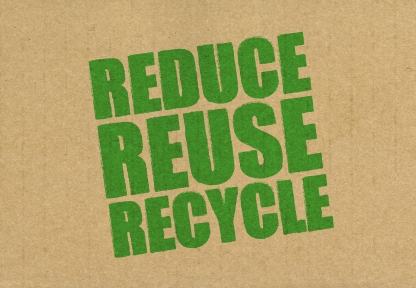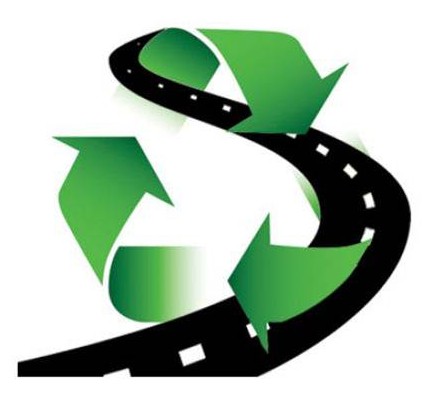Asphalt is the most sustainable paving material for constructing pavements and can be used for many applications including highways, airport runways, parking lots and driveways. Asphalt’s superiority is demonstrated by its speed of construction; environment friendliness; smooth, quiet ride and more.
for constructing pavements and can be used for many applications including highways, airport runways, parking lots and driveways. Asphalt’s superiority is demonstrated by its speed of construction; environment friendliness; smooth, quiet ride and more.
The figures speak for themselves; every day is Earth Day with Asphalt. According to data recently released by the Federal Highway Administration (FHWA):
- Over 99 percent of asphalt pavement reclaimed from roads was collected for use in new pavements
- More than 3.7 million tons of liquid asphalt binder was saved in 2011 by using Recycled Asphalt Pavement (RAP) and Recycled Asphalt Shingles (RAS)
- 69 million tons of environmentally friendly Warm Mix Asphalt (WMA) was produced in the U.S. in 2011, up 67% from 2010 and over 300% since 2009
- Crumb rubber from scrap tires is used to enhance asphalt paving mixtures, increasing the life of asphalt and creating a beneficial use from an otherwise waste product
What is sustainability?
 Sustainability is based on a simple principle: Everything that we need for our survival and well-being depends, either directly or indirectly, on our natural environment. Sustainability creates and maintains the conditions under which humans and nature can exist in productive harmony, that permit fulfilling the social, economic and other requirements of present and future generations.
Sustainability is based on a simple principle: Everything that we need for our survival and well-being depends, either directly or indirectly, on our natural environment. Sustainability creates and maintains the conditions under which humans and nature can exist in productive harmony, that permit fulfilling the social, economic and other requirements of present and future generations.
Sustainability is important to making sure that we have and will continue to have, the water, materials, and resources to protect human health and our environment.
The 3 R’s of Sustainability – Reduce, Reuse, and Recycle
Reduce – The first and most effective component is reducing created waste. Consumers are encouraged to purchase in bulk, buy items with less packaging and switch to reusable instead of single-use items. Businesses employ manufacturing methods that require fewer resources and generate less waste. In addition to benefiting the environment, these efforts often offer consumers and businesses the financial incentive of lower expenses in purchases.
created waste. Consumers are encouraged to purchase in bulk, buy items with less packaging and switch to reusable instead of single-use items. Businesses employ manufacturing methods that require fewer resources and generate less waste. In addition to benefiting the environment, these efforts often offer consumers and businesses the financial incentive of lower expenses in purchases.
The Asphalt paving industry has been a leader in this area for more than thirty years. Asphalt cement/binder is unique among paving materials in that no chemical change occurs when it is heated and mixed with hot, dried aggregates in the production of asphalt concrete. Therefore, at the end of its service life it can be reclaimed and used again as asphalt cement/binder. This results in a direct 1:1 reduction in asphalt cement/binder for new mixes using recycled asphalt pavement (RAP). For example using 30% RAP in an asphalt surface mix reduces the need for new asphalt cement/binder by 30%.
Furthermore, there is no limit to how many times this process can be repeated! Contrast this to Portland cement concrete where new cement is required every time another cubic yard of concrete is produced.
Reuse
 Despite efforts to reduce the amount of waste generated, consumers and businesses still create substantial waste. Much of this waste can immediately be reused to minimize the strain on the environment and municipal waste management.
Despite efforts to reduce the amount of waste generated, consumers and businesses still create substantial waste. Much of this waste can immediately be reused to minimize the strain on the environment and municipal waste management.
Asphalt concrete from old pavements was once considered a waste material and landfilled. However, decades of research and engineering have improved the cost effectiveness of converting old asphalt into a reusable resource that has tangible value. Today, pavement engineers, government agencies and contractors regard old asphalt as an asset, not waste, and the trend to recycling and reuse continues to gain momentum as a result. Over 99 percent of asphalt pavement reclaimed from roads is collected for reuse.
Recycle
When waste is eventually discarded, segregating items for recycling from other waste is important. Recyclables include glass, newspaper, aluminum, cardboard and a surprising array of other materials but none compare to asphalt.
Asphalt pavements are THE most recycled material in the world. The asphalt industry has been recycling on a large scale since the 1970s when the Oil Embargo resulted in drastic price increases and shortages of gasoline, diesel fuel, asphalt cement/binder and other petroleum products. Research on mix properties and modifications to plant equipment were quickly done in response to the asphalt shortages at that time, and within a few years, recycling became a commonplace practice. Every year nearly 100 million tons of RAP is recycled back into new asphalt pavement in the U.S.
in the world. The asphalt industry has been recycling on a large scale since the 1970s when the Oil Embargo resulted in drastic price increases and shortages of gasoline, diesel fuel, asphalt cement/binder and other petroleum products. Research on mix properties and modifications to plant equipment were quickly done in response to the asphalt shortages at that time, and within a few years, recycling became a commonplace practice. Every year nearly 100 million tons of RAP is recycled back into new asphalt pavement in the U.S.
Virginia began asphalt recycling following successful 1979 and 1980 Virginia Department of Transportation research projects incorporating 45-50% RAP in Virginia DOT mixes. Over the past 30+ years, Virginia asphalt producers have developed mix design and processing practices that enable them to meet virgin mix properties and performance with mixes incorporating anywhere from 10 to 50 percent RAP depending on availability and specification requirements.
Greenhouse Gas Emissions
The industry has worked on other technologies that reduce air emissions including greenhouse gases and other contributors to climate change. These technologies include warm-mix asphalt (WMA), with lower emissions due to reduced temperatures; development of cold recycling technologies to produce up to 100% recycled asphalt mixes; and asphalt pavements that never wear out which reduce greenhouse gas emissions by reducing the frequency of repair and degree of replacement. And modern asphalt technology has delivered asphalt pavement designs that actually enhance the quality of stormwater runoff even as they improve driving safety by reducing the amount of spray and noise produced by vehicle tires.
Past, current and future advancements in asphalt as an environmentally sustainable paving material are especially important because asphalt is such a primary component of America’s transportation system and because the quantities of material used annually are so large. Of the 2.6 million miles of paved roads in the United States, over 94 percent are surfaced with asphalt. Approximately 85 percent of the nation’s airfield pavements and 85 percent of the parking lots are also surfaced with asphalt.